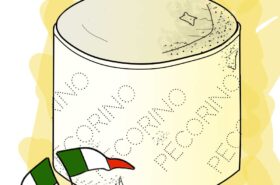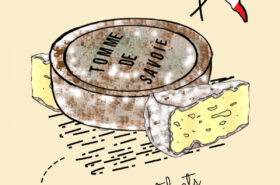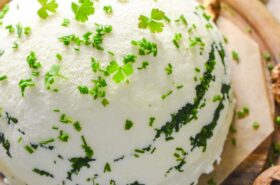For those enchanted by the world of cheese, Mimolette needs no introduction. This iconic French fromage, celebrated for its eye-catching visage and unmistakable taste, beckons us into a realm of culinary delight. Join us in this exploration of the captivating universe that surrounds Mimolette – from its historical roots to its individualistic appearance, cultural significance, and yes, even a touch of controversy that adds spice to its cheesy narrative. Get ready for a journey through the intriguing layers of Mimolette’s story, where each bite is a passport to a rich and flavorful experience!
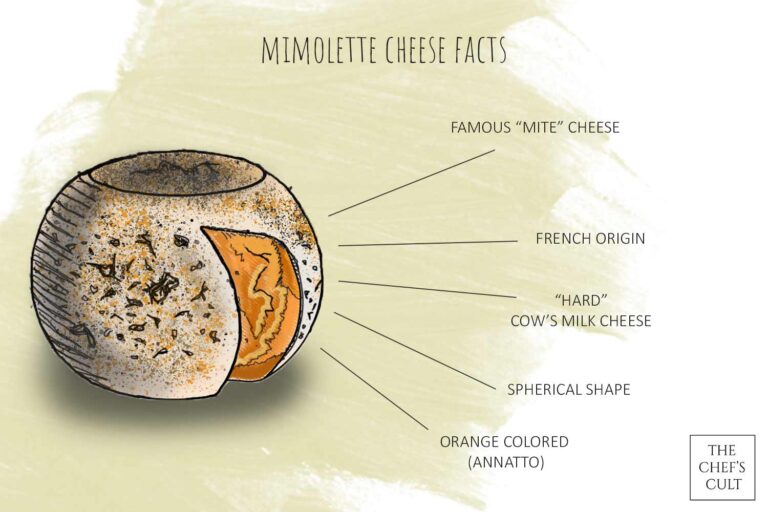
The history of Mimolette cheese
Mimolette cheese, with roots dating back over a century, has a fascinating history bridging Dutch origins and a subsequent French evolution. Originating from Dutch Edam in the early 17th century, the cheese gained popularity in France during Louis XIV’s reign. Faced with trade restrictions, French cheesemakers in Lille and Flanders adapted Edam to local resources, birthing Mimolette in the 1700s.
By the late 18th century, Mimolette established itself regionally in France, boasting a unique flavor and eye-catching appearance. This cheese pays homage to its Dutch influence with a round shape, reminiscent of Edam, but adds a distinctly French touch, incorporating annatto for an orange hue that sets it apart.
Where is Mimolette made?
Mimolette, affectionately dubbed “Boule de Lille” for its charmingly round and compact form, pays homage to its roots in the city of Lille, nestled in the Hauts-de-France region of France. As the epicenter of Mimolette production for over a century, Lille boasts historical ties to this cheese. This delightful nickname, where “Boule” playfully translates to “ball” in French, encapsulates the cheese’s whimsical appearance.
In the cheese world’s amusing tradition of associating regional names, encountering the moniker “Boule de Lille” ensures you’re in for a taste of the unique and renowned Mimolette, a cheese that rolls with both tradition and humor.
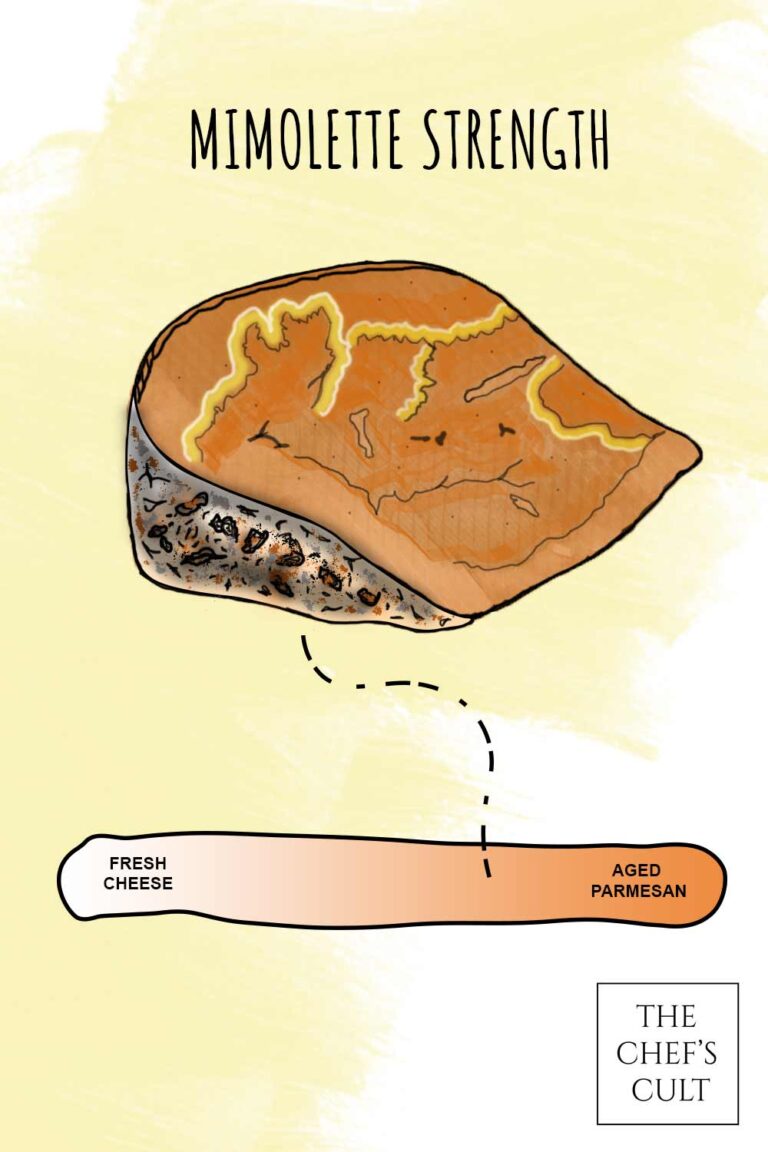
What is the taste of Mimolette cheese?
The taste and appearance of Mimolette cheese can be divided into 4 types:
1. Mimolette Jeune (Young)
In its juvenile state, Mimolette, known as Mimolette Jeune, undergoes a maturation period of 3 to 6 months, resulting in a texture that is creamy yet slightly firm and supple. The taste profile of this younger variant is characterized by a mild and subtly nutty flavor, complemented by a delicate hint of sweetness. Visually, Mimolette Jeune boasts a pale orange hue, marked by surface pits and crevices that are less pronounced compared to its aged counterparts. This youthful Mimolette is crafted for those who prefer a milder cheese experience!
2. Mimolette Demi Vieille (Semi-Aged)
In the realm of Mimolette, the Semi-Aged variation, aptly named Mimolette Demi-Vieille, matures for a span of 6 to 12 months. This phase has a texture that is firmer and crumbly, retaining a subtle creaminess. The flavor journey of this semi-matured version takes a delightful turn, offering a more pronounced nuttiness accompanied by a nuanced undercurrent of sweetness. Visually, it has a deeper orange hue, evolving with time to showcase increased pits and crevices on its surface. Striking a harmonious balance between mild and robust, Semi-Aged Mimolette beckons connoisseurs to indulge in its versatile charm!
3. Mimolette Vieille (Aged)
Aged Mimolette, or Mimolette Vieille, matures for 13 to 18 months, yielding a firm, crumbly texture with a crystalline crunch. Its flavor is an intense symphony of nuttiness and complexity, accentuated by deep caramelized notes. Visually, it boasts a deep orange to amber color, marked by abundant pits and crevices, and a pronounced crust. A culinary delight for any connoisseur!
4. Mimolette Extra Vieille (Extra Aged)
Embarking on the pinnacle of maturity, Extra-Aged Mimolette, aged for 18 months or more, boasts a texture that is exceptionally firm, crumbly, and abundantly crystalline. Its flavor unfolds as a lavish indulgence in rich and intense nuttiness, concluding with a lingering, savory finish. Visually striking, it exhibits a deep amber to brown color, adorned with an abundance of profound pits and a robust, crusty exterior. A real gem!
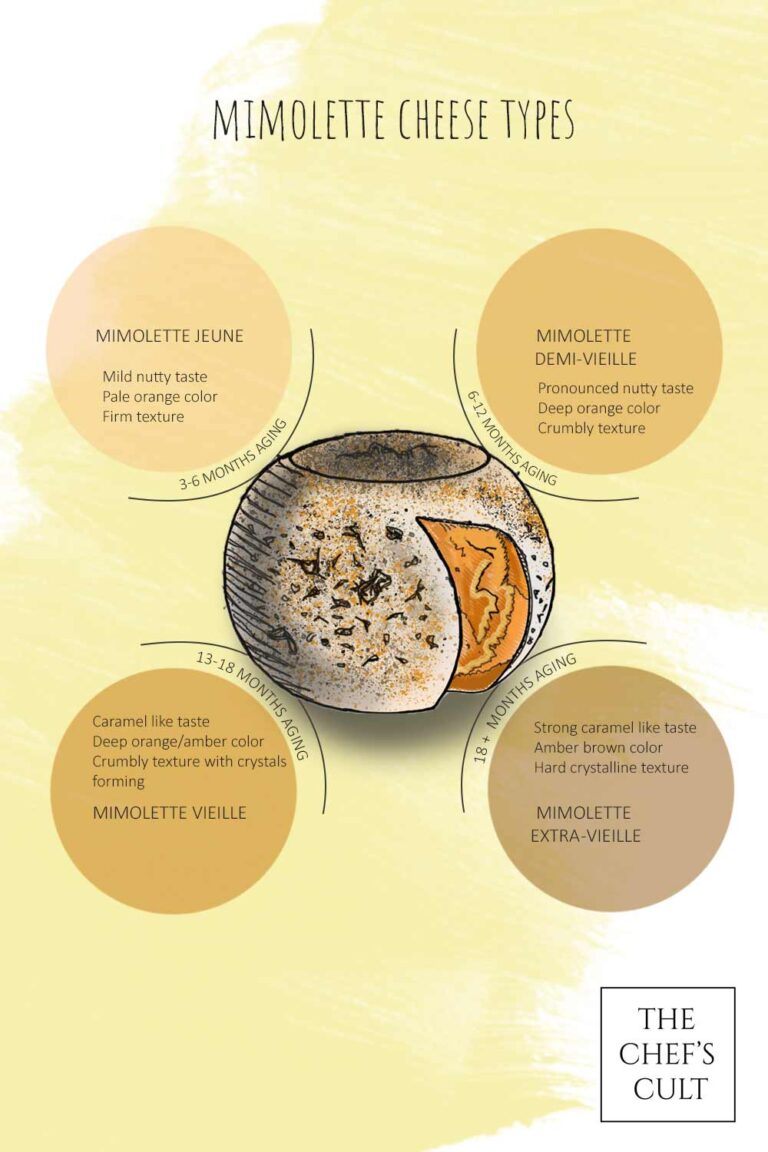
How is Mimolette made?
1. Milk Management:
Mimolette creation commences with the utilization of locally sourced cow’s milk, which undergoes meticulous scrutiny for quality. Post-inspection, the milk undergoes a sequence of treatments including bactofugation, microfiltration, ultrafiltration, centrifugation, and mixing. Following this, it undergoes pasteurization and standardization before being heated in a vat.
2. Vat Craft and Curd Formation:
Within the cheese vat, the milk experiences a series of pivotal steps:
– Inoculation with lactic and maturation ferments.
– A minimum two-hour milk ripening period achieved by introducing mesophilic lactic bacteria.
– Addition of annatto to get the characteristic orange hue.
– Introduction of rennet, initiating coagulation.
– During coagulation, the milk transforms into curd, retaining whey within its structure.
– To concentrate valuable milk components like proteins (casein) and fat, a drainage process is executed, involving operations to achieve the desired dry matter content and prevent potential defects like a sticky crust.
– Cutting the curd into smaller grains to enhance drainage surface area.
– Washing the curd grains with water, resulting in a higher pH level.
– Final stirring completes this phase, allowing the curd to naturally undergo gradual acidification.
3. Moulding, Pressing, and Unmoulding:
The cheese vat’s contents move to a pre-pressing vat where curd aggregates post-whey filtration. Cut curd blocks are then placed into molds, shaping the cheese while aiding whey drainage through acidification. This acidification, initiated during vat work, corresponds to lactose fermentation into lactic acid by the added bacteria.
4. Salt Integration:
Mimolette embraces salting through immersion in brine, imparting a distinctive flavor and influencing subsequent aging. Salt also impacts microorganism and enzyme development, playing a protective role by slowing down these processes and complementing the drainage phase.
5. Drying:
The drying phase, termed ressuyage, involves eliminating excess surface moisture from the cheeses after brine immersion.
6. Affinage:
Crucial to determining the final quality, the aging process engages various biochemical transformations of curd constituents (casein, fat, and soluble milk components) under microbial enzymes. Atmospheric composition, water availability, temperature, and pH influence microbial development and mite proliferation. Each cheese undergoes care routines such as turning and brushing. Post-aging, Mimolette attains its unique organoleptic qualities, defining its appearance, texture, taste, and aroma.
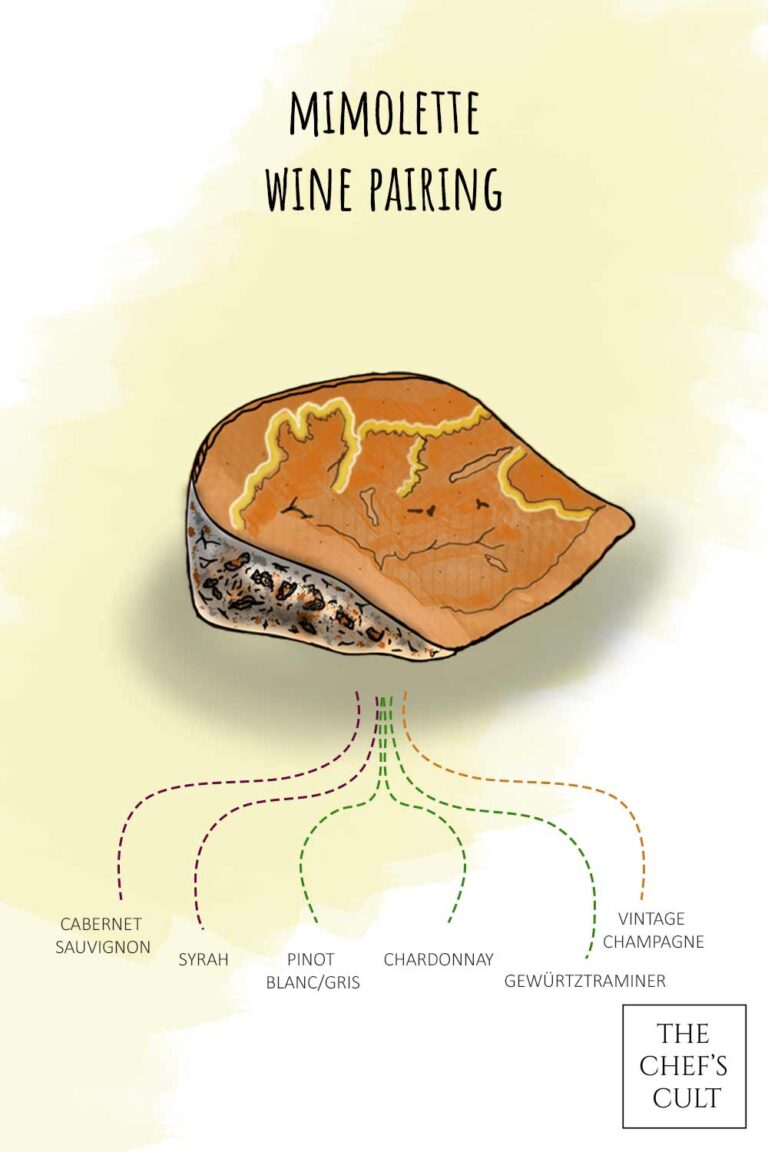
Mimolette wine pairing
Mimolette is a hard cheese which varies in aroma and taste depending on the maturation time. Young and semi aged Mimolette cheese has only a subtle nuttiness and almost sweetness to it, which balances really well with some lighter alcohol and wine acidity. Therefore, fresh medium bodied white wines like Pinot Blanc, Pinot Gris or Chardonnay do really well. Their acidity cuts right through the still young cheese! If you like to give it a more aromatic twist, go with Gewürztraminer, which has a floral (think rose petals) and exotic nose, which gives the pairing a more modern approach.
If you’re pairing the aged and extra aged Mimolette cheese styles, then more full-bodied wines would be the ideal pairing. Some aged reds like aged Cabernet Sauvignon or Syrah will give you the needed kick! If you really want to make it a once-in-a-lifetime experience, get out your extra aged Mimolette and your vintage Champagne, take a warm bath just for yourself and celebrate life! Hell yea! Cheers!
What are cheese mites?
Frequently referred to as the “cheese mite” or “flour mite,” Acarus siro, a minute arachnid belonging to the Acaridae family, is intricately linked with cheeses, notably those like Mimolette. Measuring a mere 0.3 to 0.6 millimeters (depending on the mites gender), these microscopic mites are imperceptible to the naked eye, requiring a microscope for observation. Flourishing in dim, moist, and cool environments, these mites find their ideal dwelling in cheese ageing cellars.
Their involvement in the cheese production and ageing stages contributes significantly to the distinctive characteristics of the final product. By feasting on the cheese’s surface, they carve pits and holes, enabling air penetration and fostering the breakdown of fats and proteins. This nuanced activity plays a pivotal role in shaping the cheese’s texture and intensifying its flavor, transforming these tiny creatures into essential artisans of Mimolette’s unique culinary identity.
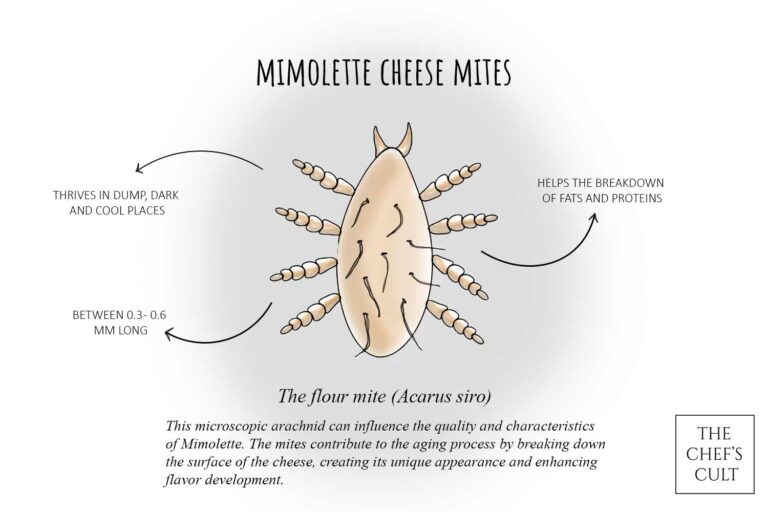
The FDA Mimolette controversy
The controversy erupted in 2013 when the FDA labeled Acarus siro, the cheese mite, as an allergen. During an inspection of a shipment from France, the FDA found mite density on the Mimolette rind exceeding their 6 mites per cubic inch regulation (yes, you heard it right, there’s regulation even for mites). Consequently, a temporary ban on Mimolette sales in the United States ensued, triggering fervent debates within the cheese community.
The ban thrust Mimolette into the spotlight, sparking discussions not only among cheese enthusiasts but also in mainstream media. Advocates, including cheese mongers and connoisseurs, rallied for Mimolette’s return, emphasizing its historical significance and unique appeal.
Producers made adjustments to meet FDA regulations, altering humidity, temperature, and aging room conditions to discourage mite proliferation. These changes paved the way for Mimolette’s return to American cheese counters, except for the Extra-Vieille version. Ironically, the controversy inadvertently heightened Mimolette’s popularity, captivating new audiences and sparking increased curiosity in exploring other artisanal and specialty cheeses.
And now, “Voilà, mes amis! Mimolette, the cheese that ages with more style than a French poodle in a fashion show. Its story, as captivating as a French film, unfolds with a blend of tradition, humor, and a dash of controversy – truly, the cheese with a certain ‘je ne sais quoi.’ So, grab your baguette, uncork that wine, and let Mimolette whisk you away on a fromage-filled adventure. C’est la vie de cheese, mes amis!”
